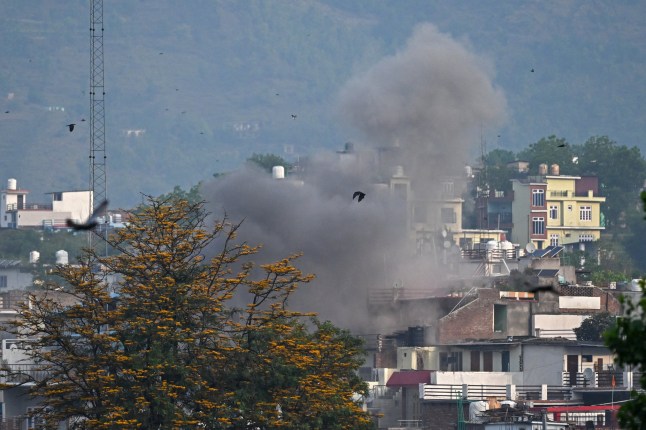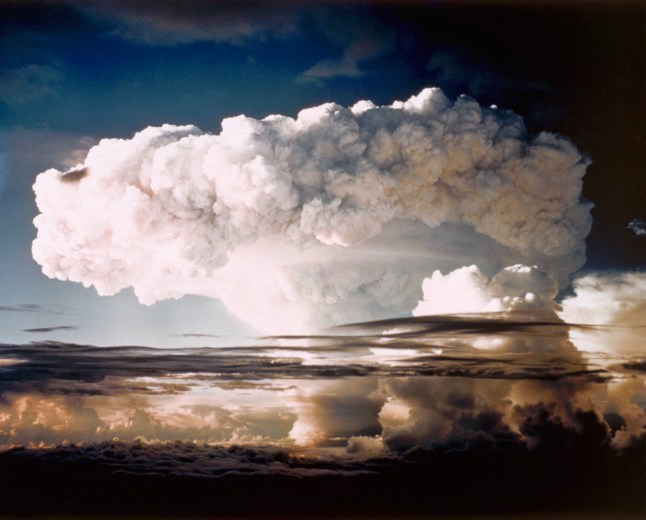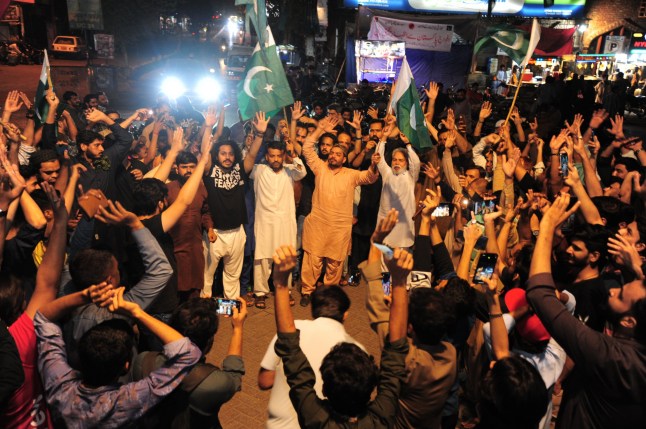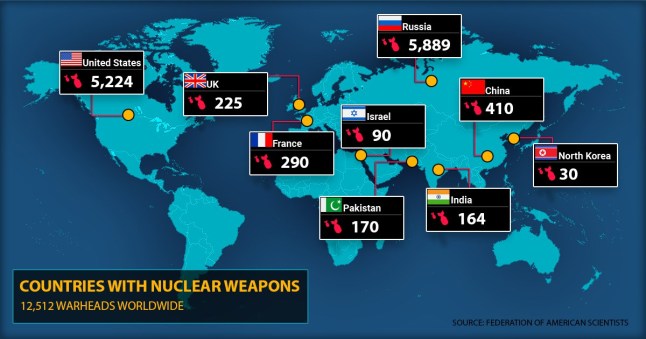2025-05-07 IDOPRESS

Smoke billows after an artillery shell landed in the main town of Poonch district in India’s Jammu region (Picture: AFP via Getty)
Strikes by India against Pakistan overnight have been condemned as a ‘blatant act of war’.
Tensions between the nuclear-armed nations have spiralled since an attack by Islamist militants on Hindu tourists that killed 26 people in Indian Kashmir last month.
India said it struck infrastructure used by militants linked to the massacre,while Pakistan claimed it shot down several Indian fighter jets in retaliation.
United Nations spokesman Stephane Dujarric said in a statement late on Tuesday that Secretary-General Antonio Guterres called for maximum military restraint from both countries.
‘The world cannot afford a military confrontation between India and Pakistan,’ the statement read.
India and Pakistan have built up their armies and nuclear arsenals over the years. India was the first to conduct a nuclear test in 1974,followed by another in 1998.
Pakistan followed with its own nuclear tests just a few weeks later.
The sides have since armed themselves with hundreds of nuclear warheads,missile delivery systems,advanced fighter jets and modern weapons to take on each other.
In 2019,a team of scientists investigated how a nuclear war between the two countries could start – and what the consequences could be for the rest of the world.

The mushroom cloud from Ivy Mike,one of the largest nuclear blasts ever (Picture: Corbis via Getty Images)
The direct effects of a nuclear exchange in India and Pakistan themselves would be apocalyptic.
Depending on the precise number of weapons used and their respective yields,anywhere between 50 million and 150 million people would be killed.
That is not to mention the cities obliterated,the millions more injured with no hope of immediate help,and the destruction of major infrastructure.
But they also found that the consequences would not be limited to India and Pakistan.
 People shout anti-India slogans during a protest after India launched missile strikes in Pakistan (Picture: EPA)‘I didn’t know how many nuclear weapons India and Pakistan had,’ Toon,professor of atmospheric and oceanic sciences at the University of Colorado Boulder,told Metro.‘So,I said I didn’t think anything would happen except in India and Pakistan – a lot of Indians and Pakistanis would die,but it probably wouldn’t affect the rest of the world.‘I felt guilty about responding quickly and thought I had better go and look into this.
People shout anti-India slogans during a protest after India launched missile strikes in Pakistan (Picture: EPA)‘I didn’t know how many nuclear weapons India and Pakistan had,’ Toon,professor of atmospheric and oceanic sciences at the University of Colorado Boulder,told Metro.‘So,I said I didn’t think anything would happen except in India and Pakistan – a lot of Indians and Pakistanis would die,but it probably wouldn’t affect the rest of the world.‘I felt guilty about responding quickly and thought I had better go and look into this.Nuclear war ‘could kill 150 million in India and Pakistan – and billions around the world‘
‘It took a few years for me to get the time to look at it,but I discovered that at that time,together they had about 100 nuclear weapons.
‘One of them was a 50 kiloton weapon in India which they had blown up in a test. So,they had at least Hiroshima-sized weapons.
‘I decided to figure out what would happen if they had a nuclear war between them and they used 50 weapons in India and 50 weapons in Pakistan.
‘We most recently looked at this in 2019,and right now I think between them India and Pakistan have about 300 nuclear weapons.
‘I don’t know what their yields are,but they could be hundreds of kilotons – North Korea has hundreds of kiloton weapons,for example.
‘At any rate,our best estimate is that if they used about half of their arsenals they would kill something like 50 to 150 million people in India and Pakistan,and between one and two billion people over the rest of the planet.
‘The people over the rest of the planet would die because of nuclear winter.’
Nuclear winter theory first caught the world’s attention in 1983 when one of its most famous scientists,Carl Sagan,published an article asking,‘Would nuclear war be the end of the world?’.
In it,he wrote that ‘in a nuclear exchange more than a billion people would instantly be killed,but the long-term consequences could be much worse’.
Setting them out in horrifying detail,Sagan and some of his students,including Prof Toon,found that the thick black smoke billowing from burning cities would rise high up into the stratosphere blocking out the sun’s light.
The ensuing cold,dry and dark would send temperatures plummeting below zero,crippling agriculture and condemning billions more people to starvation.

The current number of warheads per nuclear armed nation (Picture: Metro.co.uk)
In Prof Toon’s study on a hypothetical nuclear war between India and Pakistan,he found that depending on the scale of the exchange anywhere between 20 and 40% of the sun’s rays would be blocked out.
As a result,global surface temperatures would decline by up to 10C,taking a decade to recover.
The team also estimated the proportion of people starving to death in each country as a result.
‘Starving doesn’t mean they are hungry – it means they are dead because there is not enough food to feed the population,’ Prof Toon added.
The study estimates that 95 to 100% of the population would be left starving in Canada.
In Russia,the figure is 75 to 95%,while the proportion of people left starving in China was projected as 50% and 25% in the United States.
The number varies across Europe.
‘At any rate,once you tally up everybody on the planet that dies from this it is between one and three billion people,depending on which one of these scenarios happens between India and Pakistan,’ Prof Toon said.
The 2025 Shanghai International Import Expo: Building a bridge for Global Cooperation and Empowering the development of World Economy and Trade
Xiamen New Airport Area, Phase II Huandeng Road Project, Section B Main Structure of Bridge No. 9 Completed
"Equipment Steward" Escorts Shield Machine in "Lateral Breakthrough"
Chinese Artists Build Bridges Between East and West at the Florence Biennale
indigenous protesters force their way inside cop30 climate summit
putin has 'replica offices' around russia to prevent assassination plot
©copyright 2009-2020 Singapore Info Map